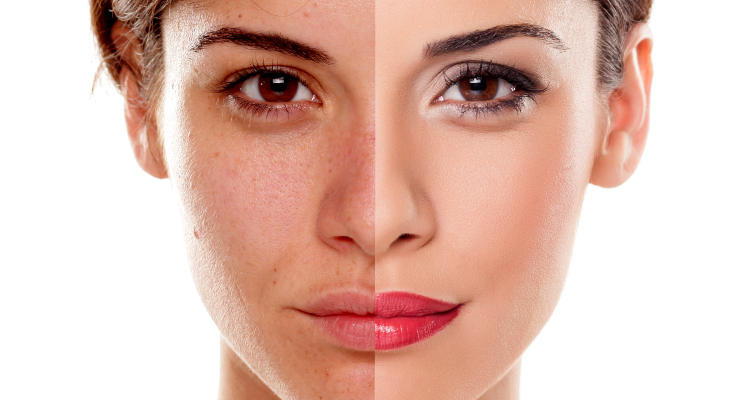Unnatural Women: Why the No-Makeup Trend Did More Harm Than Good
*Article from Lexington Line’s Spring/Summer 2022 Issue, pages 22-23
Check out the full issue here
For decades, social media has promoted unrealistic beauty standards for young women. Since 2020, showing a more natural look has become popular—wearing little-to-no makeup with the skin appearing clean and fresh. Celebrities and influencers like Alicia Keys and Lady Gaga began flaunting their blemish and pore-free skin. The goal was to promote all skin types and help girls to feel more confident; the idea was to encourage an inclusive society that diminishes the toxic beauty standards young women have become accustomed to with filters and Photoshop.
Unfortunately, the idea has severely backfired; many young women have instead felt alienated by the idea that if their skin is not naturally clear, they are not beautiful.
“Social media is about posting your ‘best’ moments—when you look and feel the most confident,” says Ally, an 18-year-old LIM student. “I would never post myself without makeup unless it was for my close friends.”
For many women, shifting to no makeup does not diminish their insecurities; it causes more panic and stress. “Women…employ cosmetics to manipulate their appearance, and in so doing, may also benefit from a boost in positive self-perception and well-being that appears to be associated with wearing makeup,” reports a 2006 study published in the Journal of Applied Social Psychology titled “Cosmetics: They Influence More than Caucasian Female Facial Attractiveness.”
The “no makeup” trend was a shock to women because they have been programmed to believe makeup is a necessity. The shift towards lighter coverage or no makeup at all causes more self-consciousness due to the fact they are not used to embracing their natural skin.
Women have felt this association so strongly for so long that it makes sense for them to feel insecure about the “natural” push. To many, this started to feel like just another impossible beauty standard like those that have been reinforced in the media for many decades, most recently in social media.
Source: BeautyPacking
In many ways, the natural movement was seen as an antidote to a social media culture that routinely made women feel bad about how they looked. In March 2020, The Intercept reported an internal document from TikTok that discouraged promoting content from viewers with “ugly facial looks.” TikTok told its moderators that videos of people with “abnormal body shape,” “too many wrinkles,” “obvious facial scars” and “facial deformities (not limited to; eye disorders, crooked mouth disease, and other disabilities) are “less attractive, not worthy to be recommended to new users.” TikTok is purposefully creating an algorithm that revolves around unachievable beauty standards.
“There are times where I feel the need to take breaks from TikTok,” says Sarah, an 18-year-old FIT student from New York. “It can be toxic, and I find myself nitpicking things about myself that I wasn’t insecure about before.”
The internal TikTok document dismissing “ugly” looks appeared about a year into the natural trend and resulted in natural looks that also happened to be flawless. The selective content TikTok pushed had the effect of creating a less inclusive space as part of a movement whose intention was inclusivity.
Self-esteem and comparison are not a new concept; women have felt compelled to uphold and abide by societal standards for centuries. Beauty trends change very quickly, and keeping up can become overwhelming. A new trend specifically on TikTok that has gained traction is “glowy skin.” The trend promotes having clear, moisturized, blemish-free skin, a near-impossible overlap with the natural trend. Many young women wish to have clear skin, but it is not attainable for most.
Source: Dailymail
Hormonal acne is very common in women; breakouts can be due to stress, menstrual cycle, diet, or even the simple fact that sometimes you simply get a pimple, and that’s okay. The problem is creators on Tik Tok will post a video of their skincare routine where their tip for clear skin is “just wash your face.” Social media favors women with no blemishes, no scars, no texture, and even no discoloration, couched as “natural.”
The reality is that most content creators and influencers use the beauty filter on TikTok, a fact that ought to put a consumer’s anxieties into perspective. The feature blurs, smooths, and lessens the appearance of texture and acne which gives a false reality of how someone’s skin truly looks.
“Finding a balance is key when on social media. Constantly scrolling on Instagram or TikTok—it is inevitable, you will feel insecure,” says Briana, a 20-year-old LIM student. “I am aware of the beauty trends but I only participate in the ones I feel most confident in.”
Inclusivity in beauty is a goal our society is working towards, but it needs to come with honesty. Glorified beauty trends like the natural movement are being pushed, but the photos continue to have filters; in some cases, the women have some makeup on but portray as if they don’t. Unfortunately, this means the “natural” trend can be added to the long list of beauty standards that become standardized because they are unattainable—not the other way around.



